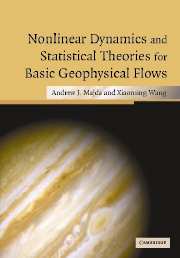Book contents
- Frontmatter
- Contents
- Preface
- 1 Barotropic geophysical flows and two-dimensional fluid flows: elementary introduction
- 2 The response to large-scale forcing
- 3 The selective decay principle for basic geophysical flows
- 4 Non-linear stability of steady geophysical flows
- 5 Topographic mean flow interaction, non-linear instability, and chaotic dynamics
- 6 Introduction to information theory and empirical statistical theory
- 7 Equilibrium statistical mechanics for systems of ordinary differential equations
- 8 Statistical mechanics for the truncated quasi-geostrophic equations
- 9 Empirical statistical theories for most probable states
- 10 Assessing the potential applicability of equilibrium statistical theories for geophysical flows: an overview
- 11 Predictions and comparison of equilibrium statistical theories
- 12 Equilibrium statistical theories and dynamical modeling of flows with forcing and dissipation
- 13 Predicting the jets and spots on Jupiter by equilibrium statistical mechanics
- 14 The statistical relevance of additional conserved quantities for truncated geophysical flows
- 15 A mathematical framework for quantifying predictability utilizing relative entropy
- 16 Barotropic quasi-geostrophic equations on the sphere
- Index
4 - Non-linear stability of steady geophysical flows
Published online by Cambridge University Press: 30 November 2009
- Frontmatter
- Contents
- Preface
- 1 Barotropic geophysical flows and two-dimensional fluid flows: elementary introduction
- 2 The response to large-scale forcing
- 3 The selective decay principle for basic geophysical flows
- 4 Non-linear stability of steady geophysical flows
- 5 Topographic mean flow interaction, non-linear instability, and chaotic dynamics
- 6 Introduction to information theory and empirical statistical theory
- 7 Equilibrium statistical mechanics for systems of ordinary differential equations
- 8 Statistical mechanics for the truncated quasi-geostrophic equations
- 9 Empirical statistical theories for most probable states
- 10 Assessing the potential applicability of equilibrium statistical theories for geophysical flows: an overview
- 11 Predictions and comparison of equilibrium statistical theories
- 12 Equilibrium statistical theories and dynamical modeling of flows with forcing and dissipation
- 13 Predicting the jets and spots on Jupiter by equilibrium statistical mechanics
- 14 The statistical relevance of additional conserved quantities for truncated geophysical flows
- 15 A mathematical framework for quantifying predictability utilizing relative entropy
- 16 Barotropic quasi-geostrophic equations on the sphere
- Index
Summary
Introduction
The observation of the geophysical flows in the atmosphere and the ocean reveal the existence of large-scale coherent flow structures. Examples of these structures are the atmospheric cyclonic and anti-cyclonic flow patterns, mesoscale ocean eddies, currents, and jets. These structures develop under fairly broad conditions and are characterized by their essentially steady nature, as well as their robustness and persistence in time. Possibly the most dramatic example of such coherent flow structures is exemplified by the Great Red Spot of Jupiter, discovered by Robert Hooke in 1664, which has persisted for at least 300 years.
From a dynamical point of view, such robust and persistent steady states must be non-linearly stable; small but finite initial perturbations of the steady states must remain small in time for the coherent flow structures to be observable. It is therefore clear that a fundamental problem is the study of the non-linear dynamical stability of the steady geophysical flows under small initial perturbations of the flow. This chapter and the next are devoted to the study of non-linear stability or instability of several classes of steady flows introduced earlier in Chapter 1. This study considers geophysical flows with topography and beta-plane effects, but without external forcing and dissipation mechanisms. In particular, we are interested in gaining a better understanding of what is the role played in the stability of the steady states by the beta-plane effect, and by the non-linear interaction of the large-scale mean flow and the small-scale flow through topographic stress.
- Type
- Chapter
- Information
- Publisher: Cambridge University PressPrint publication year: 2006



